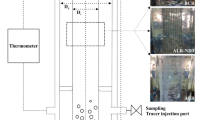Abstract
Rhizopus oryzae NRRL 395 produces optically pureL(+)-lactic acid that is highly preferred for the production of environmentally benign polymers. With xylose as the carbon source for cultivation, it can be self-immobilized as pellets with a size of about 1mm. Repeated usage of the same pellets by transferring them into fresh media every time when the glucose was exhausted over a period of 22 d yielded 1742 or 2001 g/L lactic acid total (based on 100-mL working volume) depending on the media used. Lactic acid is known to be a strong inhibitor for both growth and production, and it can be removed continuously by the adsorption on the PVP resin. With the fermenter-adsorber system, the fermentation can be performed as effectively as the ones with added neutralizing agents, such as calcium carbonate and sodium hydroxide. One problem of the fermenter-adsorber system is that lower production was obtained than in shake flasks; hence, proper reactor design is necessary to improve the process.
Similar content being viewed by others
References
Vickory, T. B. (1985), inComrehensive Biotechnology, vol. 3, Moo-Young, M., ed., Pergamon, New York, pp. 761–776.
Lipinsky, E. S. and Sinclair, R. G. (1986),Chem. Eng. Proc. 82, 26.
Lipinsky, E. S. (1981),Science 212, 1465.
Lockwood, L. B., Ward, G. E., and May, O. E. (1936),J. Ag. Res. 53, 849.
Schopmeyer, H. H. (1954), inIndustrial Fermentations, vol. 1, Underkofler, L. A. and Hickey, R. J., eds., Chemical Pub., Co., New York, pp. 391–419.
Ward, G. E., Lockwood, L. B., Tabenkin, B., and Welles, P. A. (1938),I&EC 30, 1233.
Hang, K. D., Hamamci, H., and Woodams, E. E. (1989),Biotechnol. Lett. 11, 119.
Tamada, M., Begum, A. A., and Sadi, S. (1992),J. Fer. Bioeng. 74, 379.
Hamamci, H., and Ryu, D. (1994),Appl. Biochem. Biotechnol. 44, 125.
Iyser, G. M. (1992), Ph. D. thesis, Purdue University, West Lafayette, IN.
Ward, G. E., Lockwood, L. B., May, O. E., and Herrick, H. T. (1936),J. Am. Chem. Soc. 58, 1286.
Friedmam, M. R. and Gaden, E. R., Jr. (1970),Biotechnol. Bioeng. 12, 961.
Stieber, R. W. and Gerhardt, P. (1981),Biotechnol. Bioeng. 23, 535.
Davison, B. H. and Thampson, J. E. (1992),Appl. biochem. Biotechnol. 34, 431.
Huang, F. (1987), Ph.D. thesis, Purdue University.
Author information
Authors and Affiliations
Rights and permissions
About this article
Cite this article
Yang, C.W., Lu, Z. & Tsao, G.T. Lactic acid production by pellet-formRhizopus oryzae in a submerged system. Appl Biochem Biotechnol 51, 57–71 (1995). https://doi.org/10.1007/BF02933411
Issue Date:
DOI: https://doi.org/10.1007/BF02933411




